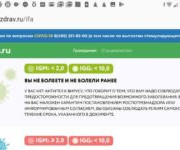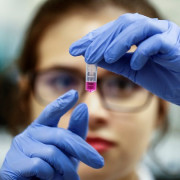Тест на антитела access sars-cov-2 igg†
Содержание:
- Набор реагентов SARS-CoV-2 Antibody Test (colloidal gold immunochromatography) для выявления антител IgM/IgG к коронавирусу иммунохроматографическим методом (20 тестов в упаковке), серии (партии): 20CG2505X, 20CG2512X, 20CG2514X, 20CG2515X, 20CG2517X
- SARS-CoV-2 antibody tests and immunity
- Почему пока рано говорить, что антитела служат надежной защитой от коронавируса
- Communicating risk and uncertainty
- Наличие антител в крови означает иммунитет к коронавирусу?
- Interpreting antibody tests
Набор реагентов SARS-CoV-2 Antibody Test (colloidal gold immunochromatography) для выявления антител IgM/IgG к коронавирусу иммунохроматографическим методом (20 тестов в упаковке), серии (партии): 20CG2505X, 20CG2512X, 20CG2514X, 20CG2515X, 20CG2517X
Сведения из Государственного реестра медицинских изделий:
Уникальный номер реестровой записи
43404
Регистрационный номер медицинского изделия
РЗН 2020/10375
Дата государственной регистрации медицинского изделия
15.05.2020
Срок действия регистрационного удостоверения
01.01.2021
Наименование медицинского изделия
Набор реагентов SARS-CoV-2 Antibody Test (colloidal gold immunochromatography) для выявления антител IgM/IgG к коронавирусу иммунохроматографическим методом (20 тестов в упаковке), серии (партии): 20CG2505X, 20CG2512X, 20CG2514X, 20CG2515X, 20CG2517X, в составе: 1. Тестовое устройство (тест-полоска) в индивидуальной вакуумной упаковке из алюминиевой фольги с осушителем — 20 уп. 2. Комплект для забора биоматериала (1 уп.) в составе: — пипетки капиллярные — 20 шт., — помпа — 1 шт. 3. Разбавитель (diluent) для разведения образцов — 1 флакон (3 мл/фл.). 4. Инструкция по применению — 1 шт.
Наименование организации — заявителя медицинского изделия
АО «Р-Фарм»
Место нахождения организации-заявителя медицинского изделия
123154, Россия, г. Москва, ул. Берзарина, д. 19, корп. 1
Юридический адрес организации-заявителя медицинского изделия
123154, Россия, г. Москва, ул. Берзарина, д. 19, корп. 1
Наименование организации-производителя медицинского изделия или организации-изготовителя медицинского изделия
«Бейджинг Лепу Медикал Технолоджи Ко., Лтд.» Beijing Lepu Medical Technology Co., Ltd.
Место нахождения организации-производителя медицинского изделия или организации — изготовителя медицинского изделия
, Китай, Building 7-1, No. 37 ChaoQian Road, Changping District, Beijing 102200, China
Юридический адрес организации-производителя медицинского изделия или организации — изготовителя медицинского изделия
, Китай, Дальнее зарубежье, Building 7-1, No. 37 Chaoqian Road, Changping District, Beijing 102200, China
Код Общероссийского классификатора продукции для медицинского изделия
21.10.60.196
Класс потенциального риска применения медицинского изделия в соответствии с номенклатурной классификацией медицинских изделий, утверждаемой Министерством здравоохранения Российской Федерации
2б (медицинские изделия с повышенной степенью риска)
Вид медицинского изделия в соответствии с номенклатурной классификацией медицинских изделий, утверждаемой Министерством здравоохранения Российской Федерации
Адрес места производства или изготовления медицинского изделия
Beijing Lepu Medical Technology Co., Ltd., Building 7-1, No. 37 Chaoqian Road, Changping District, Beijing 102200, China
SARS-CoV-2 antibody tests and immunity
Antibodies are an essential component of the adaptive immune response, providing specificity and memory against future infection. This is achieved through neutralisation by binding pathogens, activation of complement to destroy cells by lysis, presentation or opsonisation to immune cells to facilitate phagocytosis, degranulation, and antibody dependent cell mediated cytotoxicity.
However, for many viruses and intracellular infections such as tuberculosis, T cell immunity is predominant. The role of T cells following SARS-CoV-2 infection is widely discussed. T cell memory has been demonstrated in laboratory tests, and cross reactivity of T cell responses to other coronavirus infections potentially explains some of the variation in clinical severity of infection. As for most intracellular infections, it is likely that a combination of B and T cell immunity is involved in clearing covid-19 infection and generating protective memory.
Although we can test for the presence of antibodies, the extent to which SARS-CoV-2 antibodies provide future immunity and protection from repeat infection is not yet known. Experimental evidence shows neutralisation with certain SARS-CoV-2 antibodies, and inferred clinical evidence from very few reports shows repeat infection and successful use of convalescent plasma therapy. However, longitudinal studies are now reporting and showing that antibody levels are waning, and whether protective immunity will be maintained with a lower antibody titre is unknown.
To know whether our current antibody tests are indicative of protective immunity, ideally we would need disease prevalence studies in individuals with known antibody status; however, knowing whether these antibodies are neutralising in a laboratory should give us some indication before large population studies can be completed.
Почему пока рано говорить, что антитела служат надежной защитой от коронавируса

Сейчас органы здравоохранения, Минобороны и правительство США сотрудничают с представителями научных кругов и медработников, чтобы установить, действительно ли положительные тесты на антитела показывают наличие иммунитета к SARS-CoV-2. Им предстоит оценить уровень антител, необходимых для защиты от повторного заражения, длительность этой защиты, факторы, связанные с выработкой антител, и многое другое.
Хотя исследования на животных показывают защиту в краткосрочной перспективе, демонстрация долгосрочной защиты у людей потребует будущих исследований. Следовательно, до получения дополнительных данных присутствие антител нельзя отождествлять с иммунитетом человека от инфекции SARS-CoV-2.
Плюс ко всему некоторые тесты могут показать перекрестную реактивность с другими коронавирусами, например теми, что вызывают простуду. Это может привести к ложноположительным результатам теста. А некоторые люди могут не выработать обнаруживаемые антитела даже после коронавирусной инфекции.
В других случаях возможно, что уровни антител могут со временем снижаться до неопределяемых уровней (антитела IgM и IgG не присутствуют на ранних стадиях инфекции). Таким образом, результаты тестов на наличие антител не могут уверенно свидетельствовать, что человек перенес или все еще болеет коронавирусной инфекцией.
Communicating risk and uncertainty
Covid-19 offers an opportunity to improve clinician and patient understanding and communication of risk and uncertainty in diagnostic testing. Residual uncertainty after diagnostic testing is normal, and the same principles discussed here apply to most screening and diagnostic tests. We hope that the interest in covid-19 testing will lead to a wider debate around testing and test evaluation where accuracy of tests haven’t been as closely scrutinised. Clinicians should consider the risks and benefits of SARS-CoV-2 antibody testing for individuals, and share information about the limitations of testing with patients (). High quality evidence on test accuracy is currently lacking, and further research is needed to address areas of uncertainty (). A drive to increase volumes of tests performed without considering the clinical value of testing could be an expensive distraction from key public health interventions. Yet carefully considered testing, in patients with late presentation of the illness, or prolonged or atypical symptoms could help reduce uncertainty, guide ongoing management, and improve understanding of the late sequelae of covid-19.
Box 1
What you might tell your patient
-
Antibody tests help us find out who has had covid-19 in the past
-
They cannot tell us for sure whether you can catch covid-19 in the future
-
If the test is positive then it is likely that you have been infected at some time
-
A negative test result cannot rule out the possibility that you have had covid-19
Box 2
Uncertainties
-
Most studies on antibody tests are from patients in hospital. We do not know how well the tests work in patients with mild illness who were not admitted to hospital, or in people who are asymptomatic
-
Data are lacking on test accuracy beyond 35 days—we do not know how well these tests will work for infections that occurred more than five weeks ago
-
Evidence is insufficient to know whether the presence of antibodies confers lasting immunity to protect against future covid-19 infection
How patients were involved in the creation of this article
Two patient representatives from the University of Birmingham patient and public involvement panel reviewed this article. The feedback was that the article was interesting and readable, and the case studies were realistic. As a result of the feedback, we made changes to the wording of , “What you might tell your patient.”
How this article was made
This article was produced at speed to address an urgent need for evidence. JD has recently led a Cochrane systematic review of the diagnostic accuracy of covid-19 antibody tests, and this paper is based on the evidence from this systematic review, with clinical input from JW and AR.
Наличие антител в крови означает иммунитет к коронавирусу?

На этот вопрос пока сложно ответить. Почти у всех иммунокомпетентных людей (так называются клетки иммунной системы организма, способные специфически взаимодействовать с антигеном) развивается иммунный ответ после COVID-19. Подобно другим инфекциям, SARS-CoV-2 вызывает выработку антител IgM и IgG, которые являются наиболее полезными для оценки иммунного ответа (сейчас мало что известно об «ответе» IgA в крови).
В случае с SARS-CoV-2 антитела IgM и IgG возникают почти одновременно в сыворотке крови в течение 2-3 недель после начала заболевания. Таким образом, обнаружение IgM без IgG является редкостью. Как долго антитела IgM и IgG остаются обнаруживаемыми после инфекции, неизвестно.
ЦКЗ также изучил, коррелирует ли развитие нейтрализующих антител с иммунитетом к коронавирусу. По мнению исследователей, рецидив заболевания COVID-19, по-видимому, является весьма редким событием. Это позволяет предположить, что присутствие антител может обеспечить по меньшей мере кратковременный иммунитет к коронавирусной инфекции. В частности, у приматов, переболевших коронавирусом, появлялась защита от повторного заражения. Кроме того, развитие антител у человека коррелирует с заметным снижением вирусной нагрузки в дыхательных путях.
Говоря более простыми словами, наличие антител может снизить заразность человека и обеспечить некоторый уровень защиты от повторного заражения. Однако точные данные отсутствуют, и исследователи все еще не уверены, защищены ли люди с антителами (нейтрализующими или суммарными) от повторной инфекции SARS-CoV-2 и какая концентрация антител необходима для защиты.
Interpreting antibody tests
Interpretation of test results depends not only on the accuracy of the test itself but also the pre-test probability of infection. This will vary widely depending on the indication for testing: when screening asymptomatic individuals the pre-test probability will be relatively low, for those with suggestive symptoms it is likely to be much higher. We illustrate this with two (fictitious) clinical cases.
Case 1
Anthony is 53, has type 2 diabetes, and a raised body mass index. He works as a security guard in a shopping centre in Norwich. His wife is worried about his risk of exposure to covid-19 at work, and phones the GP surgery requesting an antibody test. He has not had any suggestive symptoms and has no known exposure.
Anthony’s pre-test probability can be estimated based on the population SARS-CoV-2 antibody seroprevalence in his area; in the East of England this is estimated to be around 10%. As he has had no symptoms or known exposure his probability of asymptomatic seroconversion is likely to be lower; for illustrative purposes we estimate his pre-test probability at 5%.
We do not have any data on the accuracy of antibody assays in asymptomatic people on which to base our estimates. We will start by using the average sensitivity of 91.4% and average specificity of 98.7% from the Cochrane review and consider what would change if, as is likely, the test had a lower sensitivity. illustrates the outcomes of testing based on 1000 people like Anthony, with a pre-test probability of 5%. We would expect that 942 people would test negative, of whom four (0.4%) would actually have had covid-19 (false negatives). Considering that the test may well have a lower sensitivity, particularly if the peak incidence and therefore likely time of infection is >35 days ago, this would proportionally increase the false negative rate. If the test made five times as many false negatives (sensitivity of 57%) then this would rise to 20 false negatives (2.1%)—still relatively low numbers owing to the low prevalence. A negative test result would therefore mean Anthony is unlikely to have had covid-19 infection. However, of the 58 people who would test positive, 12 people (21%) would be falsely positive. This is important because a false positive could potentially influence Anthony’s behaviour and adherence to infection control measures. This could be particularly risky as Anthony has an occupational risk of exposure and comorbidities, placing him at higher risk of complications from covid-19. The GP should therefore explain that the test result cannot be used to indicate immunity, and that regardless of the results of testing, Anthony should follow recommended precautions to avoid exposure to SARS-CoV-2. The test result in this case is therefore unlikely to change any advice given to the patient, and has the potential to cause harm through false reassurance.
Fig 1
Infographic showing outcomes of SARS-CoV-2 antibody testing based on 1000 people with a pre-test probability of 5%







